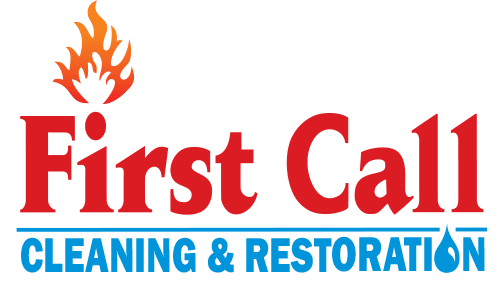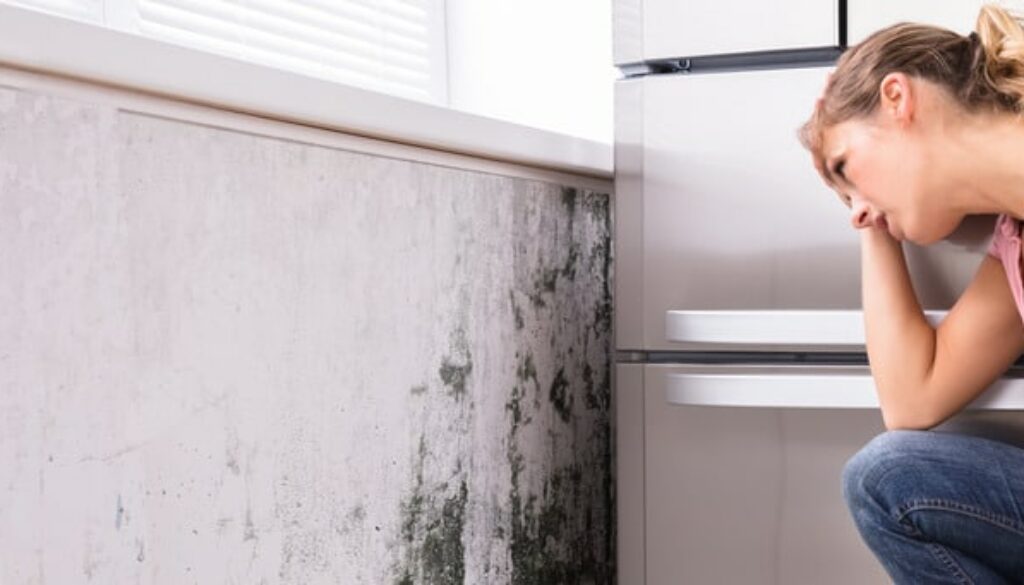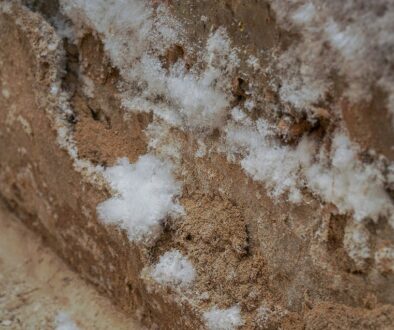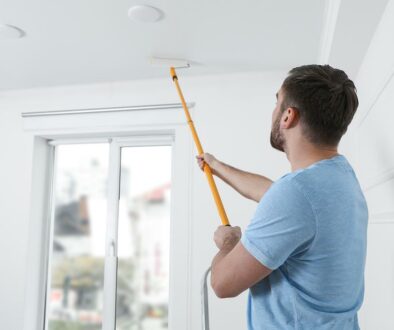Discovering types of mold in homes–particularly yours– can be both surprising and alarming. Not only can it cause damage to your property, but it can also pose health risks to you and your family. While mold can come in various forms, some types of mold in homes are more common than others.
We’ll explore the three most prevalent types of mold that you might encounter in your living spaces. By understanding these molds and their characteristics, you can take appropriate measures to prevent and mitigate their growth—and First Call can help.
3 Most Common Types of Mold in Homes
1. Stachybotrys chartarum (Black Mold)
The words strike fear in the heart of every homeowner: black mold.
One of the most infamous and commonly heard types of mold in homes is Stachybotrys chartarum, often referred to as black mold. It has gained a reputation for its dark greenish-black appearance and its association with adverse health effects.
Black mold thrives in places such as:
- Water-damaged areas
- Damp corners
- Bathrooms
- Basements
- Areas affected by leaks
- Places that have been flooded
The spores of black mold release mycotoxins, which can cause respiratory problems, allergies, and even severe health issues in some individuals.
If you suspect the presence of black mold, it is crucial to address the problem promptly—attempting to get rid of it yourself can not only potentially make the situation worse, but it can also be dangerous to your health.
2. Aspergillus
Aspergillus is a widespread genus of mold that encompasses several species. This is another one of the common types of mold in homes. It can vary in color, ranging from yellowish-green to gray.
This mold is commonly found in damp environments, including:
- Walls
- Insulation
- HVAC systems
- Food
- Other organic materials
While most species of Aspergillus are relatively harmless to humans, certain strains can cause respiratory infections and allergic reactions, especially in individuals with weakened immune systems. If you spot signs of Aspergillus mold, it is important to investigate and address the source of moisture that allowed its growth, while taking necessary precautions to avoid inhaling the spores.
But where do you begin?
First Call is the right call. We’ll address everything related to mold remediation, helping ensure the safety of your household. We’re also able to determine the specific type of Aspergillus that you’ve discovered.
Remember, there may be mold hiding in places you’re not aware of, so it’s always a good idea to enlist the services of professionals.
3. Penicillium
Penicillium is another commonly encountered type of mold in homes. It is known for its blue or green appearance and musty odor. This mold can grow on a variety of surfaces, including:
- Walls
- Carpets
- Wallpaper
- Food items
Although some species of Penicillium are used in the production of antibiotics and cheeses, certain strains can cause health issues. Prolonged exposure to Penicillium spores can trigger allergic reactions, respiratory problems, and even contribute to the development of asthma.
Identifying and eliminating sources of excess moisture, improving ventilation, and maintaining proper humidity levels can help prevent Penicillium growth in your home.
What Does House Mold Look Like?
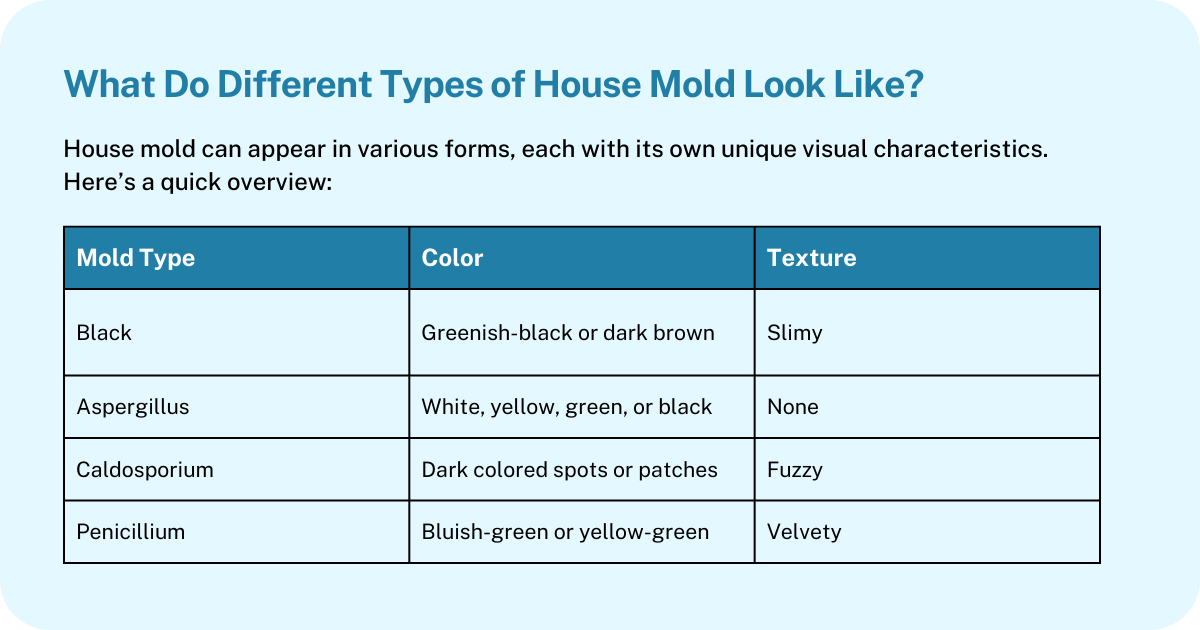
How Do I Know What Kind of Mold Is in My House?
Identifying the specific visual characteristics of types of mold in homes is crucial for homeowners to take appropriate measures to address the issue promptly and ensure a healthy living environment. But it can often be difficult to determine what type of mold you have, and disturbing it may inadvertently release spores throughout your house.
If you have mold and you’re not sure how to identify it, contact our team at First Call (it’s always the right call!)
Did You Discover a Type of Mold Growth in Your Home? Save Yourself the Headache and Leave it to the Experts!
When it comes to types of mold in homes, awareness is key. Understanding the most common types of mold that can invade your living spaces empowers you to identify and address the issue promptly.
While Stachybotrys chartarum, commonly known as black mold, garners significant attention, molds such as Aspergillus and Penicillium are also prevalent.
Remember, prevention is the first line of defense against mold growth. We suggest that you:
- Regularly inspect your home for signs of moisture
- Fix leaks promptly
- Ensure proper ventilation
- Maintain adequate humidity levels.
If you suspect mold growth, seek professional assistance from our team to assess the situation and carry out appropriate remediation measures.
By being proactive in preventing and addressing mold issues, you can create a healthier and safer living environment for you and your loved ones.
For Mold Remediation You Can Trust, First Call Is the Right Call
If you’re concerned about mold in your home, don’t hesitate to take action. Safeguarding your health and protecting your property should be your top priorities.
At First Call, we understand the importance of prompt and professional mold remediation. With our expertise and dedication to customer satisfaction, we can help you address mold issues effectively and efficiently.
We prioritize your well-being. Our team utilizes industry-leading techniques and state-of-the-art equipment to conduct thorough mold inspections and assessments. We then develop customized remediation plans tailored to your specific needs, ensuring that all affected areas are treated and the underlying causes of mold growth are addressed.
We proudly serve various locations throughout North Carolina. Whether you reside in Raleigh, Durham, Chapel Hill, or the surrounding areas, our team is ready to assist you in tackling your mold concerns. Ready to get started? Contact us today.
